


This photo taken on May 28, 2025 shows a canal in Linhe District of Bayannur, north China's Inner Mongolia Autonomous Region.
Nestled at the top of the Yellow River's "Great Bend" and in the heart of the Hetao Plain, Bayannur is a city nurtured by the Yellow River, renowned as a granary of northern China.
The word Bayannur means "abundant lake" in Mongolian, perfectly describing the region's water resources. Viewed from above, the Hetao Irrigation Area reveals an extensive 64,000-kilometer network of irrigation channels that nourish the entire city, making it both the largest irrigation system in the Yellow River Basin and the largest single-source gravity-fed irrigation system in Asia.
The Sanshenggong Water Control Project serves as the sole water source for the Hetao Irrigation Area. The project's dam divides the river flow, with one branch flowing into the main canal that sustains the agricultural heartland, while the other continues downstream.
As part of the World Heritage Irrigation Structures, the ingenuity of the Hetao Irrigation Area lies in its dual function of water deliver and drainage. After irrigating farmlands, excess water flows through the main drainage canal into Ulansuhai Nur, creating a sustainable balance between human activity and water resources. (Xinhua/Li Zhipeng)
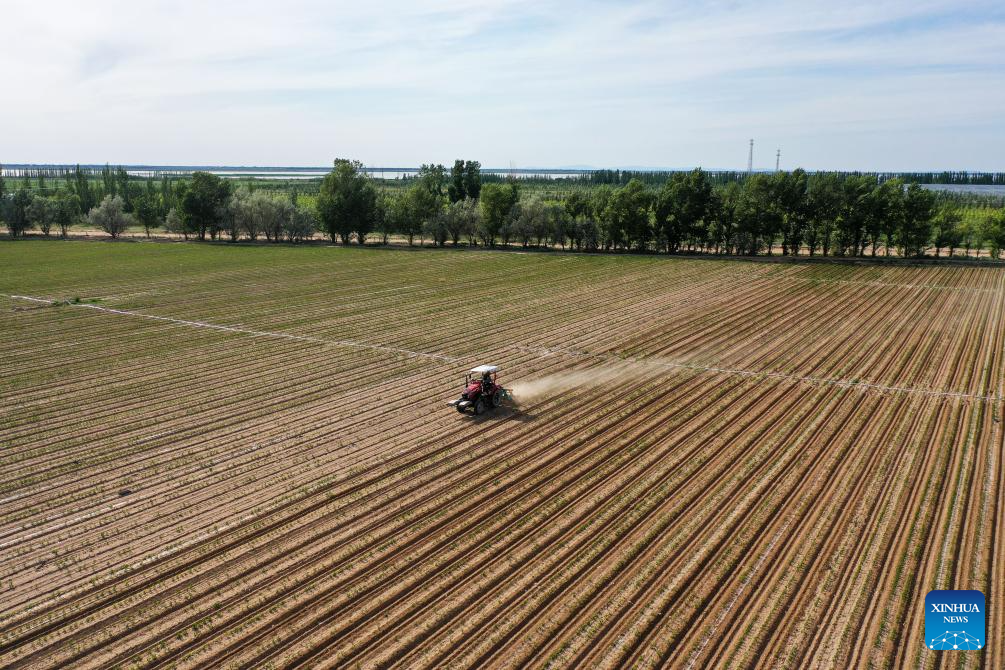
A farmer operates agricultural machinery in farmlands in Urad Front Banner of Bayannur, north China's Inner Mongolia Autonomous Region, June 4, 2025.
Nestled at the top of the Yellow River's "Great Bend" and in the heart of the Hetao Plain, Bayannur is a city nurtured by the Yellow River, renowned as a granary of northern China.
The word Bayannur means "abundant lake" in Mongolian, perfectly describing the region's water resources. Viewed from above, the Hetao Irrigation Area reveals an extensive 64,000-kilometer network of irrigation channels that nourish the entire city, making it both the largest irrigation system in the Yellow River Basin and the largest single-source gravity-fed irrigation system in Asia.
The Sanshenggong Water Control Project serves as the sole water source for the Hetao Irrigation Area. The project's dam divides the river flow, with one branch flowing into the main canal that sustains the agricultural heartland, while the other continues downstream.
As part of the World Heritage Irrigation Structures, the ingenuity of the Hetao Irrigation Area lies in its dual function of water deliver and drainage. After irrigating farmlands, excess water flows through the main drainage canal into Ulansuhai Nur, creating a sustainable balance between human activity and water resources. (Xinhua/Li Zhipeng)

An aerial drone photo taken on May 28, 2025 shows the second diversion hub of the main canal in Linhe District of Bayannur, north China's Inner Mongolia Autonomous Region.
Nestled at the top of the Yellow River's "Great Bend" and in the heart of the Hetao Plain, Bayannur is a city nurtured by the Yellow River, renowned as a granary of northern China.
The word Bayannur means "abundant lake" in Mongolian, perfectly describing the region's water resources. Viewed from above, the Hetao Irrigation Area reveals an extensive 64,000-kilometer network of irrigation channels that nourish the entire city, making it both the largest irrigation system in the Yellow River Basin and the largest single-source gravity-fed irrigation system in Asia.
The Sanshenggong Water Control Project serves as the sole water source for the Hetao Irrigation Area. The project's dam divides the river flow, with one branch flowing into the main canal that sustains the agricultural heartland, while the other continues downstream.
As part of the World Heritage Irrigation Structures, the ingenuity of the Hetao Irrigation Area lies in its dual function of water deliver and drainage. After irrigating farmlands, excess water flows through the main drainage canal into Ulansuhai Nur, creating a sustainable balance between human activity and water resources. (Xinhua/Ma Jinrui)
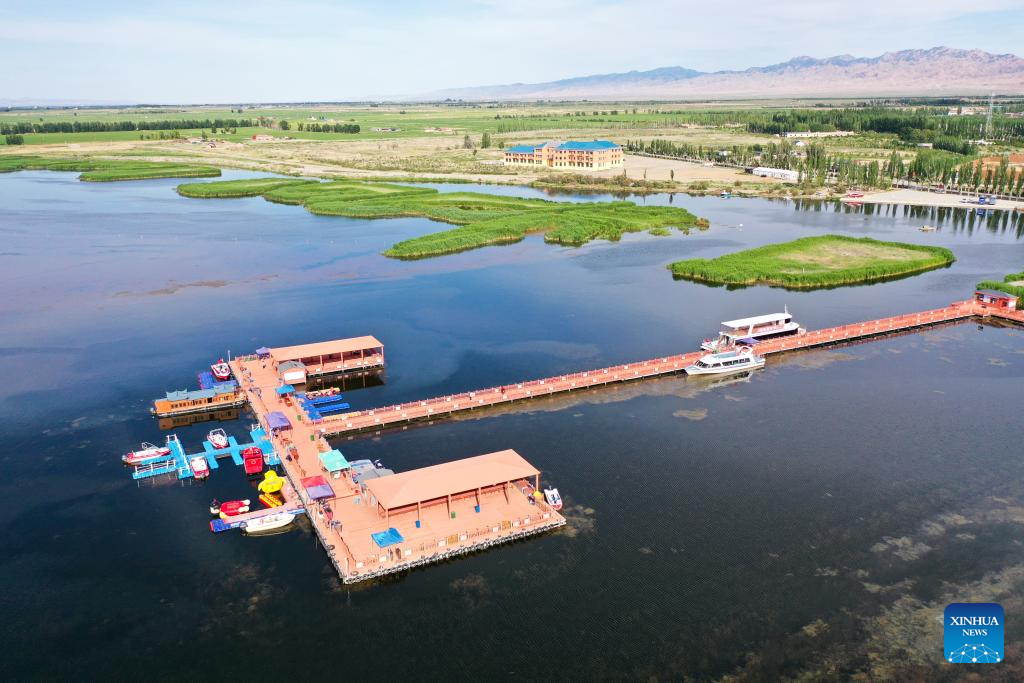
An aerial drone photo taken on June 4, 2025 shows the Ulansuhai Nur in Bayannur, north China's Inner Mongolia Autonomous Region.
Nestled at the top of the Yellow River's "Great Bend" and in the heart of the Hetao Plain, Bayannur is a city nurtured by the Yellow River, renowned as a granary of northern China.
The word Bayannur means "abundant lake" in Mongolian, perfectly describing the region's water resources. Viewed from above, the Hetao Irrigation Area reveals an extensive 64,000-kilometer network of irrigation channels that nourish the entire city, making it both the largest irrigation system in the Yellow River Basin and the largest single-source gravity-fed irrigation system in Asia.
The Sanshenggong Water Control Project serves as the sole water source for the Hetao Irrigation Area. The project's dam divides the river flow, with one branch flowing into the main canal that sustains the agricultural heartland, while the other continues downstream.
As part of the World Heritage Irrigation Structures, the ingenuity of the Hetao Irrigation Area lies in its dual function of water deliver and drainage. After irrigating farmlands, excess water flows through the main drainage canal into Ulansuhai Nur, creating a sustainable balance between human activity and water resources. (Xinhua/Li Zhipeng)
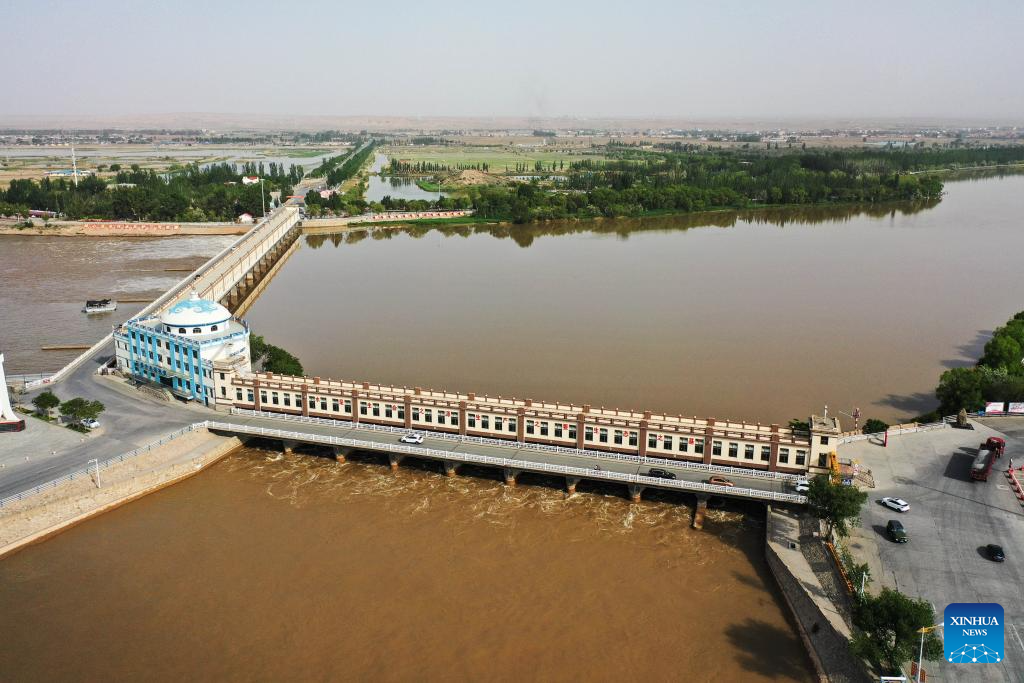
An aerial drone photo taken on May 28, 2025 shows the Sanshenggong Water Control Project in Dengkou County of Bayannur, north China's Inner Mongolia Autonomous Region.
Nestled at the top of the Yellow River's "Great Bend" and in the heart of the Hetao Plain, Bayannur is a city nurtured by the Yellow River, renowned as a granary of northern China.
The word Bayannur means "abundant lake" in Mongolian, perfectly describing the region's water resources. Viewed from above, the Hetao Irrigation Area reveals an extensive 64,000-kilometer network of irrigation channels that nourish the entire city, making it both the largest irrigation system in the Yellow River Basin and the largest single-source gravity-fed irrigation system in Asia.
The Sanshenggong Water Control Project serves as the sole water source for the Hetao Irrigation Area. The project's dam divides the river flow, with one branch flowing into the main canal that sustains the agricultural heartland, while the other continues downstream.
As part of the World Heritage Irrigation Structures, the ingenuity of the Hetao Irrigation Area lies in its dual function of water deliver and drainage. After irrigating farmlands, excess water flows through the main drainage canal into Ulansuhai Nur, creating a sustainable balance between human activity and water resources. (Xinhua/Li Zhipeng)

An aerial drone photo taken on May 28, 2025 shows the second diversion hub of the main canal in Linhe District of Bayannur, north China's Inner Mongolia Autonomous Region.
Nestled at the top of the Yellow River's "Great Bend" and in the heart of the Hetao Plain, Bayannur is a city nurtured by the Yellow River, renowned as a granary of northern China.
The word Bayannur means "abundant lake" in Mongolian, perfectly describing the region's water resources. Viewed from above, the Hetao Irrigation Area reveals an extensive 64,000-kilometer network of irrigation channels that nourish the entire city, making it both the largest irrigation system in the Yellow River Basin and the largest single-source gravity-fed irrigation system in Asia.
The Sanshenggong Water Control Project serves as the sole water source for the Hetao Irrigation Area. The project's dam divides the river flow, with one branch flowing into the main canal that sustains the agricultural heartland, while the other continues downstream.
As part of the World Heritage Irrigation Structures, the ingenuity of the Hetao Irrigation Area lies in its dual function of water deliver and drainage. After irrigating farmlands, excess water flows through the main drainage canal into Ulansuhai Nur, creating a sustainable balance between human activity and water resources. (Xinhua/Ma Jinrui)
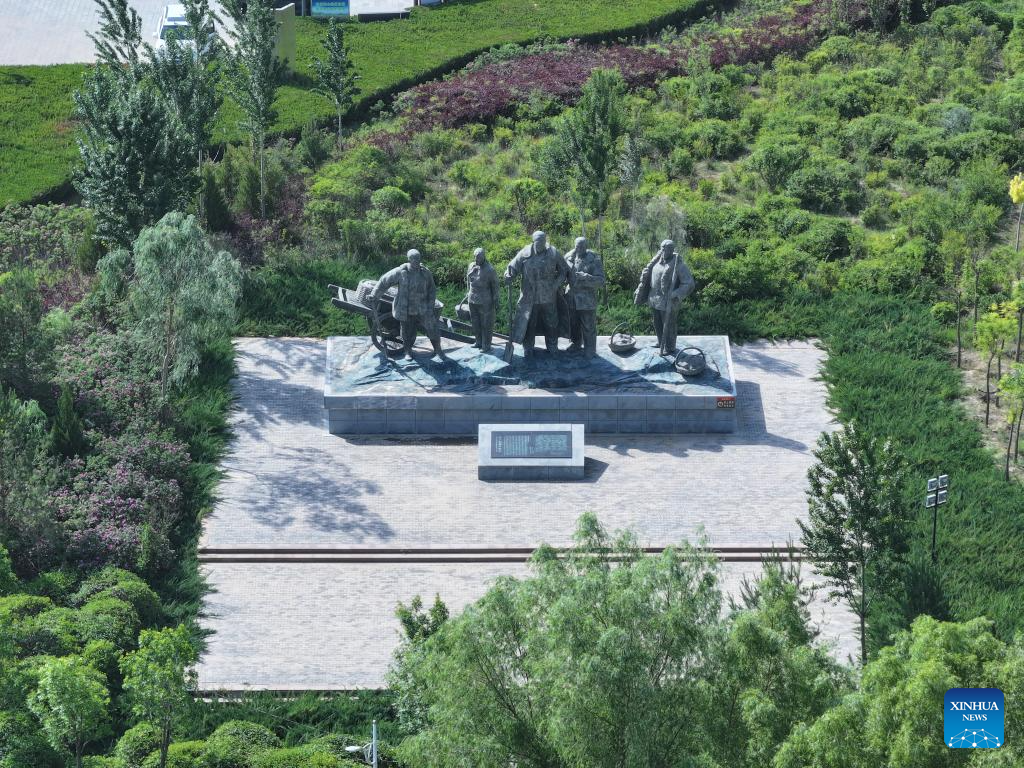
An aerial drone photo taken on May 28, 2025 shows a commemorative sculpture near the main canal in Linhe District of Bayannur, north China's Inner Mongolia Autonomous Region.
Nestled at the top of the Yellow River's "Great Bend" and in the heart of the Hetao Plain, Bayannur is a city nurtured by the Yellow River, renowned as a granary of northern China.
The word Bayannur means "abundant lake" in Mongolian, perfectly describing the region's water resources. Viewed from above, the Hetao Irrigation Area reveals an extensive 64,000-kilometer network of irrigation channels that nourish the entire city, making it both the largest irrigation system in the Yellow River Basin and the largest single-source gravity-fed irrigation system in Asia.
The Sanshenggong Water Control Project serves as the sole water source for the Hetao Irrigation Area. The project's dam divides the river flow, with one branch flowing into the main canal that sustains the agricultural heartland, while the other continues downstream.
As part of the World Heritage Irrigation Structures, the ingenuity of the Hetao Irrigation Area lies in its dual function of water deliver and drainage. After irrigating farmlands, excess water flows through the main drainage canal into Ulansuhai Nur, creating a sustainable balance between human activity and water resources. (Xinhua/Ma Jinrui)
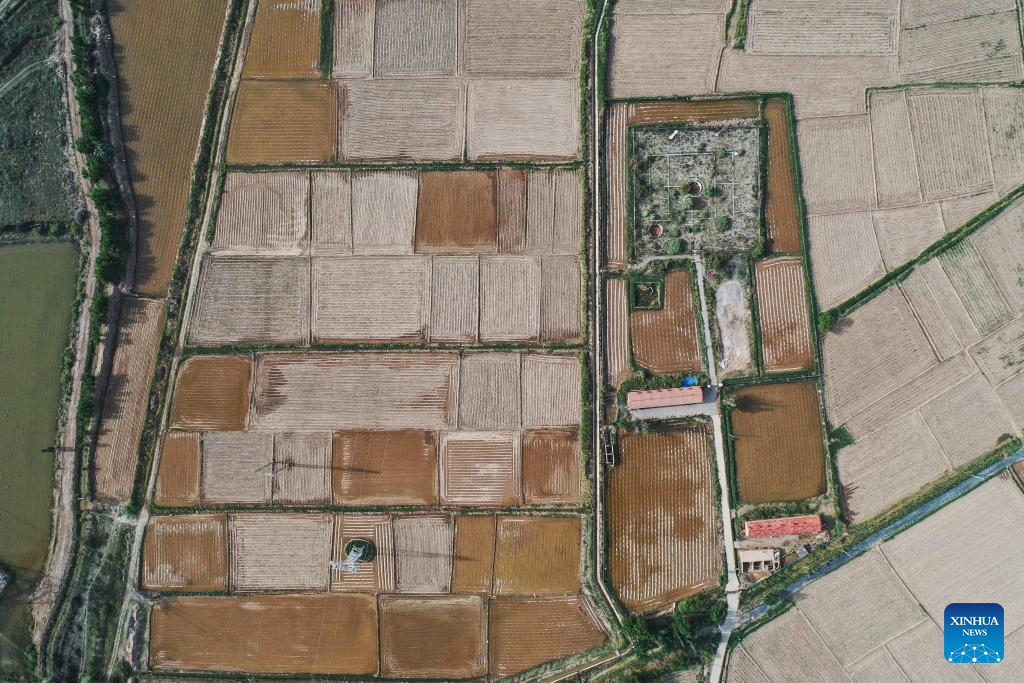
An aerial drone photo taken on May 28, 2025 shows farmlands in Dengkou County of Bayannur, north China's Inner Mongolia Autonomous Region.
Nestled at the top of the Yellow River's "Great Bend" and in the heart of the Hetao Plain, Bayannur is a city nurtured by the Yellow River, renowned as a granary of northern China.
The word Bayannur means "abundant lake" in Mongolian, perfectly describing the region's water resources. Viewed from above, the Hetao Irrigation Area reveals an extensive 64,000-kilometer network of irrigation channels that nourish the entire city, making it both the largest irrigation system in the Yellow River Basin and the largest single-source gravity-fed irrigation system in Asia.
The Sanshenggong Water Control Project serves as the sole water source for the Hetao Irrigation Area. The project's dam divides the river flow, with one branch flowing into the main canal that sustains the agricultural heartland, while the other continues downstream.
As part of the World Heritage Irrigation Structures, the ingenuity of the Hetao Irrigation Area lies in its dual function of water deliver and drainage. After irrigating farmlands, excess water flows through the main drainage canal into Ulansuhai Nur, creating a sustainable balance between human activity and water resources. (Xinhua/Li Zhipeng)

Farmers irrigate crops in Linhe District of Bayannur, north China's Inner Mongolia Autonomous Region, May 28, 2025.
Nestled at the top of the Yellow River's "Great Bend" and in the heart of the Hetao Plain, Bayannur is a city nurtured by the Yellow River, renowned as a granary of northern China.
The word Bayannur means "abundant lake" in Mongolian, perfectly describing the region's water resources. Viewed from above, the Hetao Irrigation Area reveals an extensive 64,000-kilometer network of irrigation channels that nourish the entire city, making it both the largest irrigation system in the Yellow River Basin and the largest single-source gravity-fed irrigation system in Asia.
The Sanshenggong Water Control Project serves as the sole water source for the Hetao Irrigation Area. The project's dam divides the river flow, with one branch flowing into the main canal that sustains the agricultural heartland, while the other continues downstream.
As part of the World Heritage Irrigation Structures, the ingenuity of the Hetao Irrigation Area lies in its dual function of water deliver and drainage. After irrigating farmlands, excess water flows through the main drainage canal into Ulansuhai Nur, creating a sustainable balance between human activity and water resources. (Xinhua/Li Zhipeng)

An aerial drone photo taken on May 28, 2025 shows the Sanshenggong Water Control Project in Dengkou County of Bayannur, north China's Inner Mongolia Autonomous Region.
Nestled at the top of the Yellow River's "Great Bend" and in the heart of the Hetao Plain, Bayannur is a city nurtured by the Yellow River, renowned as a granary of northern China.
The word Bayannur means "abundant lake" in Mongolian, perfectly describing the region's water resources. Viewed from above, the Hetao Irrigation Area reveals an extensive 64,000-kilometer network of irrigation channels that nourish the entire city, making it both the largest irrigation system in the Yellow River Basin and the largest single-source gravity-fed irrigation system in Asia.
The Sanshenggong Water Control Project serves as the sole water source for the Hetao Irrigation Area. The project's dam divides the river flow, with one branch flowing into the main canal that sustains the agricultural heartland, while the other continues downstream.
As part of the World Heritage Irrigation Structures, the ingenuity of the Hetao Irrigation Area lies in its dual function of water deliver and drainage. After irrigating farmlands, excess water flows through the main drainage canal into Ulansuhai Nur, creating a sustainable balance between human activity and water resources. (Xinhua/Ma Jinrui)

This photo taken on May 28, 2025 shows a canal in Linhe District of Bayannur, north China's Inner Mongolia Autonomous Region.
Nestled at the top of the Yellow River's "Great Bend" and in the heart of the Hetao Plain, Bayannur is a city nurtured by the Yellow River, renowned as a granary of northern China.
The word Bayannur means "abundant lake" in Mongolian, perfectly describing the region's water resources. Viewed from above, the Hetao Irrigation Area reveals an extensive 64,000-kilometer network of irrigation channels that nourish the entire city, making it both the largest irrigation system in the Yellow River Basin and the largest single-source gravity-fed irrigation system in Asia.
The Sanshenggong Water Control Project serves as the sole water source for the Hetao Irrigation Area. The project's dam divides the river flow, with one branch flowing into the main canal that sustains the agricultural heartland, while the other continues downstream.
As part of the World Heritage Irrigation Structures, the ingenuity of the Hetao Irrigation Area lies in its dual function of water deliver and drainage. After irrigating farmlands, excess water flows through the main drainage canal into Ulansuhai Nur, creating a sustainable balance between human activity and water resources. (Xinhua/Li Zhipeng)
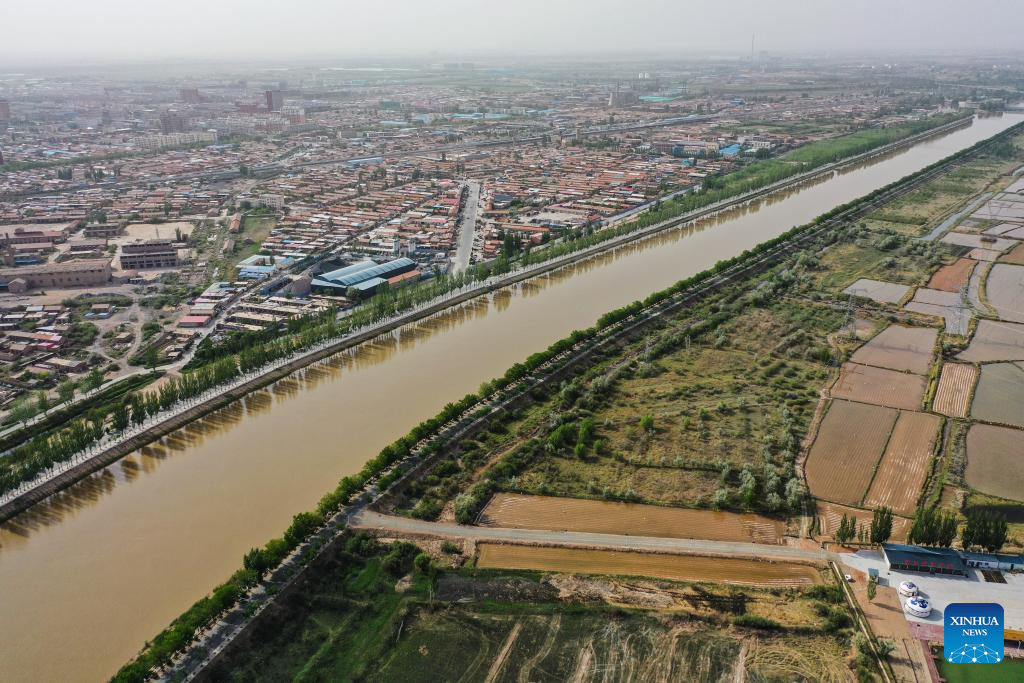
An aerial drone photo taken on May 28, 2025 shows the main canal in Dengkou County of Bayannur, north China's Inner Mongolia Autonomous Region.
Nestled at the top of the Yellow River's "Great Bend" and in the heart of the Hetao Plain, Bayannur is a city nurtured by the Yellow River, renowned as a granary of northern China.
The word Bayannur means "abundant lake" in Mongolian, perfectly describing the region's water resources. Viewed from above, the Hetao Irrigation Area reveals an extensive 64,000-kilometer network of irrigation channels that nourish the entire city, making it both the largest irrigation system in the Yellow River Basin and the largest single-source gravity-fed irrigation system in Asia.
The Sanshenggong Water Control Project serves as the sole water source for the Hetao Irrigation Area. The project's dam divides the river flow, with one branch flowing into the main canal that sustains the agricultural heartland, while the other continues downstream.
As part of the World Heritage Irrigation Structures, the ingenuity of the Hetao Irrigation Area lies in its dual function of water deliver and drainage. After irrigating farmlands, excess water flows through the main drainage canal into Ulansuhai Nur, creating a sustainable balance between human activity and water resources. (Xinhua/Li Zhipeng)
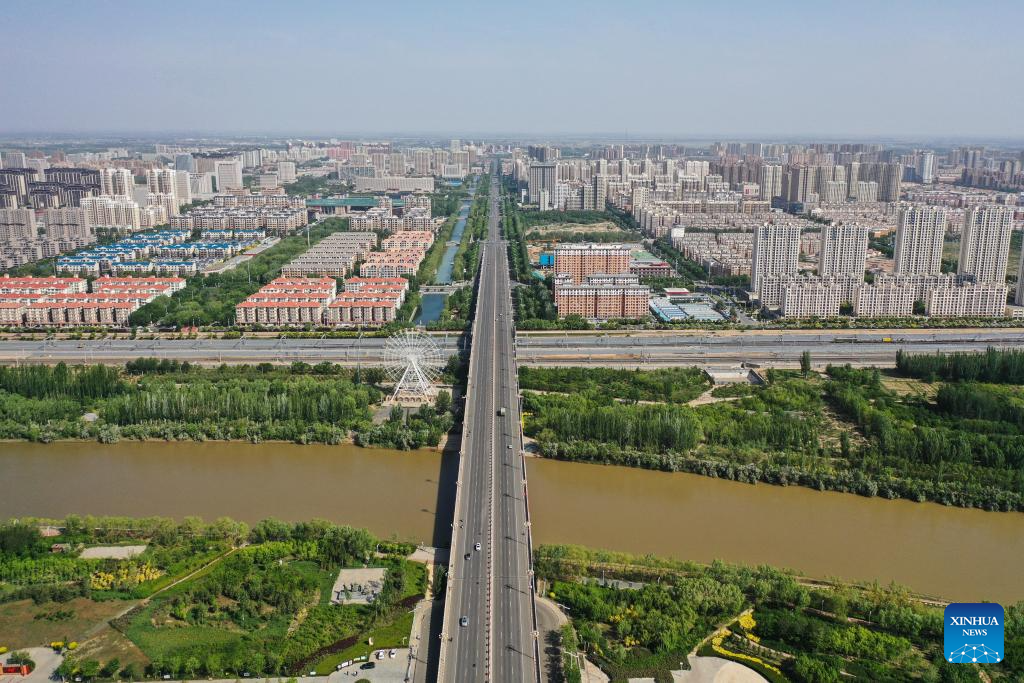
An aerial drone photo taken on May 28, 2025 shows the main canal in Linhe District of Bayannur, north China's Inner Mongolia Autonomous Region.
Nestled at the top of the Yellow River's "Great Bend" and in the heart of the Hetao Plain, Bayannur is a city nurtured by the Yellow River, renowned as a granary of northern China.
The word Bayannur means "abundant lake" in Mongolian, perfectly describing the region's water resources. Viewed from above, the Hetao Irrigation Area reveals an extensive 64,000-kilometer network of irrigation channels that nourish the entire city, making it both the largest irrigation system in the Yellow River Basin and the largest single-source gravity-fed irrigation system in Asia.
The Sanshenggong Water Control Project serves as the sole water source for the Hetao Irrigation Area. The project's dam divides the river flow, with one branch flowing into the main canal that sustains the agricultural heartland, while the other continues downstream.
As part of the World Heritage Irrigation Structures, the ingenuity of the Hetao Irrigation Area lies in its dual function of water deliver and drainage. After irrigating farmlands, excess water flows through the main drainage canal into Ulansuhai Nur, creating a sustainable balance between human activity and water resources. (Xinhua/Li Zhipeng)
点击右上角![]() 微信好友
微信好友
 朋友圈
朋友圈

请使用浏览器分享功能进行分享
